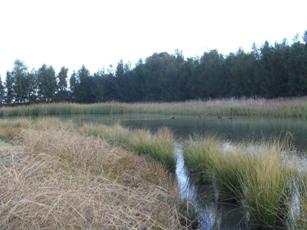
Fish friendly councils top tip 4
4. Treat stormwater prior to discharge
Many innovative water sensitive design features are available to assist with stormwater quality management. For example constructed wetlands can perform the same important ecological functions that natural wetlands do: remove nutrients and settle-out suspended sediments from water before it flows into the main waterway. However, it is important that constructed wetlands are not sited over natural wetlands or other key fish habitat.
Constructed wetlands can be used in conjunction with other stormwater quality improvement devices such as Gross Pollutant Traps (GPT) which trap large pollutants such as litter, or grassed swales and bio-retention systems which filter finer sediments. Such measures can reduce the impacts on river systems and town water supplies and have long term benefits for the environment, native fish and public health.
Council can ...
- make the installation of water sensitive devices a condition of consent for new developments
- retrofit GPTs to existing stormwater drainage systems
- seal unsealed roads adjacent to waterway crossings to reduce sediment run-off
- construct artificial wetlands to treat stormwater
- minimise stormwater pollutants by educating the local community with initiatives such as the ‘Drain is just for Rain’, ‘Follow the Yellow Fish Road’ and ‘Bin your Butts’.

Egret park constructed wetlands. Image: Dubbo City Council
Dubbo City Council uses a variety of techniques to improve storm water quality to receiving waters. Retardation basins slow the flow of water, constructed wetlands, bioswales and infiltration basins remove sediments, hydrocarbons and nutrients; while GPT trap large debris such as plastic bags and food wrappers. Egret Park in the City of Dubbo is an urban wetland which serves as a passive recreation area and assists in stormwater management.
See also
- 1. Find out about your local fish populations
- 2. Help protect key fish habitat in Council planning processes
- 3. Ensure council infrastructure is fish friendly
- 5. Protect and manage buffer areas
- 6. Maintain and enhance public reserves for river health
- 7. Collaborate with your neighbouring councils
- 8. Support local groups working on fish friendly projects (for example: Rivercare, Landcare, Indigenous groups, Fishing clubs)
- 9. Educate your local community about fish and river health
- 10. Promote your fish friendly work to the wider community

